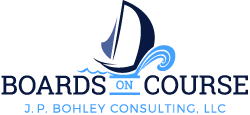Tip #48 How to Encourage Creative Thinking in Your Board Meetings
In this Tip for Effective Boards, we’ll focus on two techniques: brainstorming and catalytic questions. But first let’s begin with a few basic guidelines. Consider at least occasionally meeting in a more casual retreat setting or consider designating a portion of a more formal meeting for a less-structured, more free-flowing discussion. Allow the discussion facilitator (who may be different from the board chair) the freedom to guide discussion without needing to follow Robert’s Rules or another highly structured format.
Brainstorming. We often say “Let’s brainstorm.” But, my experience is that we generally tend to not follow the principles of brainstorming and thereby don’t reap the full benefits of using this technique. Principles of brainstorming include the follow: generate lots of ideas; when generating ideas, don’t evaluate them; encourage everyone to participate; record all ideas; and don’t rush to evaluate but let ideas percolate. Be firm about not evaluating ideas during brainstorming. Free participants from the burden of having to defend their ideas. Critiquing ideas undermines creative thinking. Encourage even what may seem like “way-out” thinking. It may stimulate many other ideas which may be more actionable. Don’t begin evaluating ideas until after the brainstorming session has been completed. (For ideas about getting everyone involved in the brainstorming session, see the previous Tip, “Tip 47: How to Get Everyone Engaged in Your Board Meetings.” Just click https://www.BoardsOnCourse.com/blog.
Catalytic Questions. What Richard Chait and others call catalytic questions are designed to help us break out of our current thinking modes and come up with different ideas or perspectives. In a board session focused on identifying potential risks to be addressed, a board may address the question: “What headline about our organization would we least like to see in the morning newspaper?” In envisioning possible and desired organizational futures, a board may ask itself: “Five years from now what would we want people to recognize as being the most important accomplishment of our organization?” In thinking about organizational priorities, we might pose questions like: “If our organization received an unexpected donation of $100,000 or a major funder reduced our funding unexpectedly by $100,000 how would we change our priorities?” For additional ideas for catalytic questions, you can check out Governance as Leadership by Richard P. Chait and others (John Wiley and Sons, 2005), pp. 123-124.
As you may remember, in our last few Tips for Effective Boards we have been discussing the 4 P’s for Building Your Board Team: Purpose, People, Plan and Process. In our upcoming Tips we will continue our discussion of the Fourth P: Manage Your Board Group Process Effectively. In these Tips, we’ll focus on the following:
- Additional techniques for encouraging creative thinking in the boardroom.
- Tips for managing disagreements and conflicts proactively and constructively.
The 4 P’s incorporate insights from the Policy Governance® model developed by John Carver, from other governance writers and from the group dynamics and team-building literature.
Please take the time to check out the Policy Governance® model. It provides a comprehensive board governance design that supports and enhances effective group process. For more information about the Policy Governance® model click https://www.BoardsOnCourse.com/policy-governance or contact me at jpbohley@gmail.com.
I will be happy to customize a workshop for your board on any or all of the 4 P’s or on the Policy Governance® model which provides an excellent governance design for the 4 P’s. If you would like more information, please respond to this email or contact me via jpbohley@gmail.com.
With this 48th Tip for Effective Boards, I’ve been writing these monthly Tips for four years. Time flies. To check out any of the other Tips for Effective Boards, please click https://www.BoardsOnCourse.com/blog.
